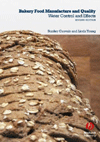Snack Food & Wholesale Bakery was recently able to talk to Judith van Peij, innovation manager baking, DSM Food Specialties, about baking innovation and using nutrients in baking.
Liz Parker: How can brands effectively fortify their baked goods with nutrients like vitamins, minerals and fatty acids, to differentiate their offerings?
Judith van Peij: With 60 percent of people now seeking foods with added nutrients like vitamins, minerals, protein or omega-3 fatty acids[1], the fortification of baked goods offers a clear opportunity for differentiation for brands in the baking industry. Indeed, adding essential micronutrients to products enables nutritional claims like ‘source of omega-3’ or ‘high in vitamin D’ and can help producers stand out on the retail shelf. However, the process of fortification can present a range of challenges for manufacturers, such as maintaining the nutrient levels and sensory properties of baked goods. Nutrients like omega-3 fatty acids and vitamins added to formulations can lose potency during production or across shelf life. Some components like vitamin D are also sensitive to light exposure, and may lose their potency during heating. Oxidation is also known to cause off-flavor notes in products enriched with ingredients such as omega-3 oil during storage—especially those formulated with trace minerals.
The latest ingredient technologies in this space can help brands overcome these obstacles to formulate great-tasting and nutrient-enriched baked goods effectively. Available in powder format, these solutions improve heat and process stability, meaning they can withstand mixing and maintain dosages during production and across products’ shelf lives. Plus, with no significant impact on taste, texture or appearance, even when used in combination with other ingredients, they can help producers combine health appeal with the eating experience that consumers expect from bakery varieties today.
LP: What types of fortifications can snack and bakery companies use, and when should they use it?
JvP: Fortifying baked goods with superstar ingredients can help producers support consumer health, while differentiating their products. Let’s consider omega-3 eicosapentaenoic acid (EPA), docosahexaenoic acid (DHA) and alpha-linolenic acid (ALA), for example, which are well-known for their wide-ranging and diverse health benefits throughout the life stages, including heart, brain and eye health. [2],[3],[4] Their role in supporting trending health concerns, including immunity, sports performance, positive mood and quality of sleep, is also becoming increasingly well recognized.[5],[6],[7],[8],[9],[10],[11],[12],[13],[14],[15],[16] High-quality, pure and sustainable omega-3 solutions, available from both fish and algae sources, can be incorporated via fortification into a broad range of bakery applications, including fresh or frozen white and whole wheat bread, rolls, bagels and tortillas, as well as cakes and muffins. This can offer an appealing choice to consumers, who are increasingly aware of the role that EPA and DHA can play in health and wellbeing.
Vitamins are also a popular choice for the fortification of baked goods, as they are widely known to support optimal health and wellbeing. For example, vitamins play a role in heart, brain and eye health, and these nutrients also show potential in improving energy levels and muscle function. The benefits of vitamins for optimizing immunity are also increasingly highlighted in today’s climate. Nutritional immune support has traditionally centered around vitamin C supplementation[17], but vitamins A, B6, B12, D and E have since all been shown to play a part in supporting a healthy immune system.[18] Vitamin A, for instance, helps to strengthen the functioning of the epithelial lining, which is considered to be the body’s first and frontline defense against infections. Meanwhile, vitamin D has been shown to reduce the risk of respiratory tract infections and support overall immunity in both children and adults[19]. And consumers are also taking note, with 62% of people reporting that they associate vitamin D with ‘boosting’ immunity.[20] Food fortification with vitamin D is particularly important as most foods do not provide the recommended daily 2000 IU (50 µg) of vitamin D (vitamin D2 or D3).[21],[22] Fortifying baked goods – like bread, tortilla wraps, muffins and cookies − with high-quality vitamins can therefore support manufacturers in meeting the needs of today’s increasingly health-conscious consumers.
Joining forces with a ‘one-stop-shop’ partner can help bakers identify the best-suited nutrients and ingredient formats for addressing consumer needs and add them to their formulations effectively. A solutions provider with end-to-end capabilities—from a broad portfolio of ingredients like vitamins, fatty acids and baking enzymes to scientific, technical and regulatory expert services—can offer producers guidance from concept to consumer.
[1] DSM, ‘Future of Food’ survey, 2020.
[2] DSM 2019 Global Health Concerns Study.
[3] Richardson A et al. Docosahexaenoic acid for reading, cognition and behavior in children aged 7-9 years: a randomized controlled trial (the DOLAB Study). Plos One, vol. 7, no. 9, 2012.
[4] Querques G et al. Retina and omega-3. J Nutr Metab., vol. 2011, pg. 748,361, 2011.
[5] Gutierrez S et al. Effects of omega-3 fatty acids on immune cells. Intl J Mol Sci., vol. 20, no. 20, pg. 5028, 2019.
[6] Calder, P.C. et al. Optimal Nutritional Status for a Well-Functioning Immune System Is an Important Factor to Protect against Viral Infections. Nutrients., vol. 12 no. 1181, 2020.
[7] Basil M.C. and Levy BD. Specialised pro-resolving mediators: endogenous regulators of infection and inflammation. Nature Reviews | Immunology, vol. 16, pg. 51-67, 2016.
[8] Macartney et al. Intrinsic heart rate recovery after dynamic exercise is improved with an increased omega-3 index in healthy males. Br J Nutr., vol. 112, no. 2, pg. 1984-1992, 2014.
[9] Buckley, Jonathan D., Shane Burgess, Karen J. Murphy, and Peter R. C. Howe. 2009. “DHA-Rich Fish Oil Lowers Heart Rate during Submaximal Exercise in Elite Australian Rules Footballers. Journal of Science and Medicine in Sport , vol.12, no. 4, pg. 503–7, 2009.
[10] . Peoples et al. Fish oil reduces heart rate and oxygen consumption during exercise. University of Wollongong, 2008.
[11] Ninio et al. Docosahexaenoic acid-rich fish oil improves heart rate variability and heart rate responses to exercise in overweight adults. Br J Nutr., vol. 100, no. 5, pg. 1097-1103, 2008.
[12] Hingley et al. DHA-rich fist oil increases the omega-3 index and lowers the oxygen cost of physiologically stressful cycling in trained individuals. Int J Sport Nutr Exerc Metab., vol. 27, no. 4, 2017.
[13] Meldrum S and Simmer K. Docosahexanoic acid and neurodevelopment outcomes of term infants. Annals of Nutrition and Metab., vol. 69 (supplement 1), pg. 23-28, 2016.
[14] Del Brutto et al. Dietary fish intake and sleep quality: a population-based study. Sleep Med., vol. 17, pg. 126-128, 2016.
[15] Montgomery P et al. Fatty acids and sleep in UK children: objective and pilot objective sleep results from the DOLAB study – a randomized controlled trial. J Sleep Res., vol. 23, no. 4, pg. 364-388, 2014.
[16] Jansen et al. Plasma DHA is related to sleep timing and duration in a cohort of Mexican Adolescents. The Journal of Nutrition, vol 150, no.30, pg. 592-598, 2020.
[17] A. F. Gombart, ‘A Review of Micronutrients and the Immune System-Working in Harmony to Reduce the Risk of Infection’, Nutrients, vol. 12, no. 1, pg. 236, 2020.
[18] Ibid.
[19] P. C. Calder et al. Optimal Nutritional Status for a Well-Functioning Immune System Is an Important Factor to Protect against Viral Infections. Nutrients, vol. 12, no. 4, pg. 1181, 2020.
[20] DSM Consumer Immunity Panel, September 2020, 24 countries globally (EMEA: Germany, UK, France, Italy, Spain, Russia, Sweden, Poland, Egypt, South Africa; Americas: US, Brazil, Mexico, Argentina, Colombia, Peru; APAC and China: India, Japan, South Korea, Indonesia, Thailand, Australia, Philippines, China).
[21] Calder et al. Optimal nutritional status for a well-functioning immune system is an important factor to protect against viral infections. Nutrients, vol. 12, no. 4, pg. 1181, 2020.
[22] United States Department of Agriculture (USDA). Scientific Report of the 2015 Dietary Guidelines Advisory Committee. Appendix E-3.3: Meeting Vitamin D Recommended Intakes in USDA Food Patterns, United States Department of Agriculture (USDA), 2015.





